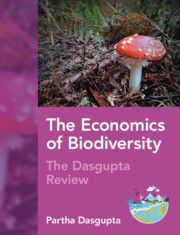Book contents
- The Economics of Biodiversity
- The Economics of Biodiversity
- Copyright page
- Contents
- List of Boxes
- Foreword
- Preface to the CUP Edition
- Preface
- Part I Foundations
- Chapter 0 How We Got to Where We Are
- Chapter 1 Nature as an Asset
- Chapter 2 Biodiversity and Ecosystem Services
- Chapter 3 Biospheric Disruptions
- Chapter 4 Human Impact on the Biosphere
- Chapter 4* The Bounded Global Economy
- Chapter 5 Risk and Uncertainty
- Chapter 6 Laws and Norms as Social Institutions
- Chapter 7 Human Institutions and Ecological Systems, 1: Unidirectional Externalities and Regulatory Policies
- Chapter 8 Human Institutions and Ecological Systems, 2:
- Chapter 8* Management of CPRs:
- Chapter 9 Human Institutions and Ecological Systems, 3:
- Chapter 10 Well-Being Across the Generations
- Chapter 11 The Content of Well-Being: Empirics
- Chapter 12 Valuing Biodiversity
- Chapter 13 Sustainability Assessment and Policy Analysis
- Chapter 13* Accounting Prices and Inclusive Wealth
- Part II Extensions
- Part III The Road Ahead
- Appendix
- Acronyms
- Glossary
- References
- Acknowledgements
- Author Index
- Subject Index
Chapter 13 - Sustainability Assessment and Policy Analysis
from Part I - Foundations
Published online by Cambridge University Press: 10 March 2025
- The Economics of Biodiversity
- The Economics of Biodiversity
- Copyright page
- Contents
- List of Boxes
- Foreword
- Preface to the CUP Edition
- Preface
- Part I Foundations
- Chapter 0 How We Got to Where We Are
- Chapter 1 Nature as an Asset
- Chapter 2 Biodiversity and Ecosystem Services
- Chapter 3 Biospheric Disruptions
- Chapter 4 Human Impact on the Biosphere
- Chapter 4* The Bounded Global Economy
- Chapter 5 Risk and Uncertainty
- Chapter 6 Laws and Norms as Social Institutions
- Chapter 7 Human Institutions and Ecological Systems, 1: Unidirectional Externalities and Regulatory Policies
- Chapter 8 Human Institutions and Ecological Systems, 2:
- Chapter 8* Management of CPRs:
- Chapter 9 Human Institutions and Ecological Systems, 3:
- Chapter 10 Well-Being Across the Generations
- Chapter 11 The Content of Well-Being: Empirics
- Chapter 12 Valuing Biodiversity
- Chapter 13 Sustainability Assessment and Policy Analysis
- Chapter 13* Accounting Prices and Inclusive Wealth
- Part II Extensions
- Part III The Road Ahead
- Appendix
- Acronyms
- Glossary
- References
- Acknowledgements
- Author Index
- Subject Index
Summary
Humanity’s future will be shaped by the portfolio of assets we inherit and choose to pass on, and by the balance we strike between the portfolio and the size of our population. Assets are durable objects, producing streams of services. Their durability enables us to save them for our own future, offer them as gifts to others, exchange them for other goods and services, and bequeath them to our children. Durability does not mean everlasting. Assets depreciate, but unlike services they are not fleeting. Perhaps because financial capital has figured prominently in economists’ writings, the qualifier ‘capital’ is sometimes added to assets, as in ‘capital assets’. Assets acquire their value from the services they provide over their remaining life (Chapter 1).
This chapter constructs a two-way classification of assets and identifies an inclusive measure of wealth based on them. It then establishes a series of propositions that reveal a deep connection between inclusive wealth and intergenerational well-being.
- Type
- Chapter
- Information
- The Economics of BiodiversityThe Dasgupta Review, pp. 327 - 362Publisher: Cambridge University PressPrint publication year: 2024

